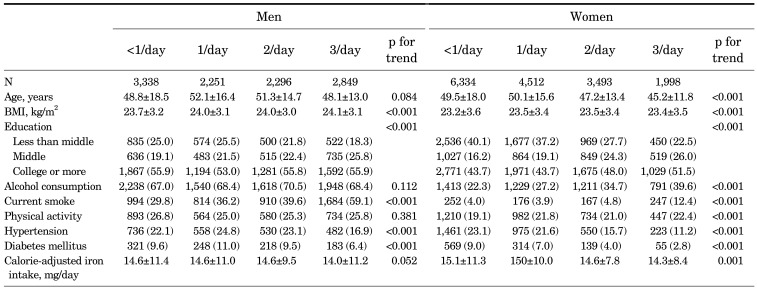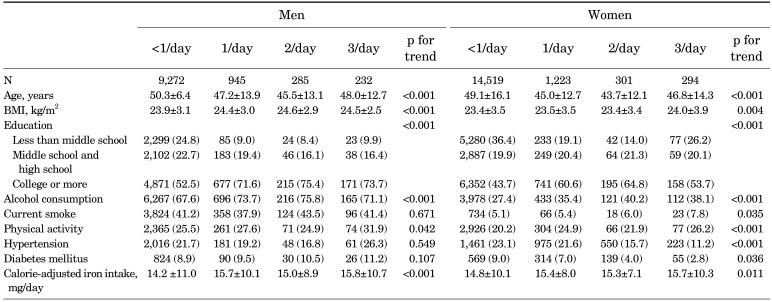1. Higdon JV, Frei B. Coffee and health: a review of recent human research. Crit Rev Food Sci Nutr. 2006; 46:101–123. PMID:
16507475.
2. Di Lorenzo A, Curti V, Tenore GC, Nabavi SM, Daglia M. Effects of tea and coffee consumption on cardiovascular diseases and relative risk factors: an update. Curr Pharm Des. 2017; 23:2474–2487. PMID:
28215148.
3. Inoue M, Kurahashi N, Iwasaki M, Shimazu T, Tanaka Y, Mizokami M, et al. Effect of coffee and green tea consumption on the risk of liver cancer: cohort analysis by hepatitis virus infection status. Cancer Epidemiol Biomarkers Prev. 2009; 18:1746–1753. PMID:
19505908.
4. McCarty MF. A chlorogenic acid-induced increase in GLP-1 production may mediate the impact of heavy coffee consumption on diabetes risk. Med Hypotheses. 2005; 64:848–853. PMID:
15694706.
5. Massey LK, Whiting SJ. Caffeine, urinary calcium, calcium metabolism and bone. J Nutr. 1993; 123:1611–1614. PMID:
8360789.
6. Graham DM. Caffeine--its identity, dietary sources, intake and biological effects. Nutr Rev. 1978; 36:97–102. PMID:
353595.
7. Morck TA, Lynch SR, Cook JD. Inhibition of food iron absorption by coffee. Am J Clin Nutr. 1983; 37:416–420. PMID:
6402915.
8. Munoz LM, Lonnerdal B, Keen CL, Dewey KG. Coffee consumption as a factor in iron deficiency anemia among pregnant women and their infants in Costa Rica. Am J Clin Nutr. 1988; 48:645–651. PMID:
3414579.
9. Mennen L, Hirvonen T, Arnault N, Bertrais S, Galan P, Hercberg S. Consumption of black, green and herbal tea and iron status in French adults. Eur J Clin Nutr. 2007; 61:1174–1179. PMID:
17299492.
10. Nelson M, Poulter J. Impact of tea drinking on iron status in the UK: a review. J Hum Nutr Diet. 2004; 17:43–54. PMID:
14718031.
11. Dewey KG, Romero-Abal ME, Quan de Serrano J, Bulux J, Peerson JM, Eagle P, et al. Effects of discontinuing coffee intake on iron status of iron-deficient Guatemalan toddlers: a randomized intervention study. Am J Clin Nutr. 1997; 66:168–176. PMID:
9209186.
12. Disler PB, Lynch SR, Charlton RW, Torrance JD, Bothwell TH, Walker RB, et al. The effect of tea on iron absorption. Gut. 1975; 16:193–200. PMID:
1168162.
13. Farkas CS, Harding le Riche W. Effect of tea and coffee consumption on non-haem iron absorption: some questions about milk. Hum Nutr Clin Nutr. 1987; 41:161–163. PMID:
3570873.
14. West AR, Oates PS. Mechanisms of heme iron absorption: current questions and controversies. World J Gastroenterol. 2008; 14:4101–4110. PMID:
18636652.
15. Mamas MA, Kwok CS, Kontopantelis E, Fryer AA, Buchan I, Bachmann MO, et al. Relationship between anemia and mortality outcomes in a national acute coronary syndrome cohort: insights from the UK myocardial ischemia national audit project registry. J Am Heart Assoc. 2016; 5:e003348. PMID:
27866164.
16. Lee JO, Lee JH, Ahn S, Kim JW, Chang H, Kim YJ, et al. Prevalence and risk factors for iron deficiency anemia in the korean population: results of the fifth Korea National Health and Nutrition Examination Survey. J Korean Med Sci. 2014; 29:224–229. PMID:
24550649.
17. Kweon S, Kim Y, Jang MJ, Kim Y, Kim K, Choi S, et al. Data resource profile: the Korea National Health and Nutrition Examination Survey (KNHANES). Int J Epidemiol. 2014; 43:69–77. PMID:
24585853.
18. Oh HL, Lee JA, Kim DH, Lim JS. Reference values for serum ferritin and percentage of transferrin saturation in Korean children and adolescents. Blood Res. 2018; 53:18–24. PMID:
29662858.
19. Willett W, Stampfer MJ. Total energy intake: implications for epidemiologic analyses. Am J Epidemiol. 1986; 124:17–27. PMID:
3521261.
20. Carlstrom M, Larsson SC. Coffee consumption and reduced risk of developing type 2 diabetes: a systematic review with meta-analysis. Nutr Rev. 2018; 76:395–417. PMID:
29590460.
21. Nordestgaard AT, Thomsen M, Nordestgaard BG. Coffee intake and risk of obesity, metabolic syndrome and type 2 diabetes: a Mendelian randomization study. Int J Epidemiol. 2015; 44:551–565. PMID:
26002927.
22. Steffen M, Kuhle C, Hensrud D, Erwin PJ, Murad MH. The effect of coffee consumption on blood pressure and the development of hypertension: a systematic review and meta-analysis. J Hypertens. 2012; 30:2245–2254. PMID:
23032138.
23. Fleming DJ, Jacques PF, Dallal GE, Tucker KL, Wilson PW, Wood RJ. Dietary determinants of iron stores in a free-living elderly population: the Framingham Heart Study. Am J Clin Nutr. 1998; 67:722–733. PMID:
9537620.
24. Mehta SW, Pritchard ME, Stegman C. Contribution of coffee, and tea to anemia among NHANES II participants. Nutr Res. 1992; 12:209–222.
25. Brune M, Rossander L, Hallberg L. Iron absorption and phenolic compounds: importance of different phenolic structures. Eur J Clin Nutr. 1989; 43:547–557. PMID:
2598894.
26. Siegenberg D, Baynes RD, Bothwell TH, Macfarlane BJ, Lamparelli RD, Car NG, et al. Ascorbic acid prevents the dose-dependent inhibitory effects of polyphenols and phytates on nonheme-iron absorption. Am J Clin Nutr. 1991; 53:537–541. PMID:
1989423.
27. Imai K, Nakachi K. Cross sectional study of effects of drinking green tea on cardiovascular and liver diseases. BMJ. 1995; 310:693–696. PMID:
7711535.
28. Root MM, Hu J, Stephenson LS, Parker RS, Campbell TC. Iron status of middle-aged women in five counties of rural China. Eur J Clin Nutr. 1999; 53:199–206. PMID:
10201801.
29. Hallberg L, Hulthen L. Prediction of dietary iron absorption: an algorithm for calculating absorption and bioavailability of dietary iron. Am J Clin Nutr. 2000; 71:1147–1160. PMID:
10799377.
30. Soustre Y, Dop MC, Galan P, Hercberg S. Dietary determinants of the iron status in menstruating women. Int J Vitam Nutr Res. 1986; 56:281–286. PMID:
3781753.






 PDF
PDF ePub
ePub Citation
Citation Print
Print




 XML Download
XML Download